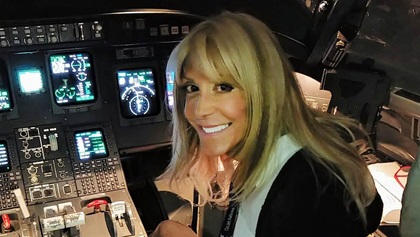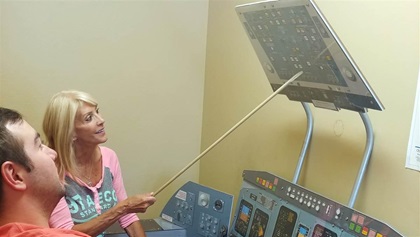Career Paths: New hire
You want to be an airline pilot and you’re how old?

I had worked at the same flight school for 10 years. Most recently, my role as chief flight instructor at an FAA Part 141 flight school and director of AeroCamp for young teens proved extremely rewarding. I evolved immensely in these roles and while never complacent, I was comfortable to the point where I could do the job in my sleep. It was time to step out and endure some discomfort.
Be careful what you wish for.
In the 1980s, as a co-host for the nationally syndicated TV Show PM Magazine, I was approached by the General Aviation Manufacturers Association (GAMA) with the life-changing invitation to learn to fly—for free through first solo—in exchange for featuring my journey on the show. After my televised solo, I was smitten and footed the bill from there.
Being a TV personality was always my forte. Flying was simply an incredibly joyful side hustle, never a career goal. I did make a few attempts ages ago to take the airline path, but life happened. By age 63, these life events had resolved and I was encouraged to apply to an airline by my flight students and associates who swear an airline pilot job is the bomb. It was a long shot for this aging fly girl. With no previous Part 121 time at my age, I assumed I was not a desirable pilot candidate for an airline.
Surprise, surprise.
I had multiple offers from regional carriers, and chose one based solely on its vivacious recruiter whose enthusiasm was contagious. I studied for the technical interview, did well, and was hired. I received a standard conditional job offer that warns new hires not to quit their jobs, since the offer is contingent upon completing all the training—fewer than 50 percent make it through.
My boss granted me a leave of absence from the flight school, threw a send-off party, and hung a plaque in the flight school entryway congratulating me on my move to the airlines. It felt awkward. I reminded him there was no job guarantee. My boss was convinced I would be successful. With much excitement, I was off to my new life.
I’m not sure what I expected, but it was not what I had envisioned.
With no previous Part 121 time at my age, I assumed I was not a desirable pilot candidate for an airline. Surprise, surprise.Like everyone else in my class, I started off with high hopes and great enthusiasm for this new chapter. But all too quickly, the mood declined. I was told life at the regional airline pilot level is the pits. Apparently this was common knowledge. The employees at the airline and my training classmates who had been with other carriers swore all regionals suck. You must pay the price of shabby treatment now to reap the benefits years down the road after moving up to a major airline. I didn’t have time to reap such benefits. Was this really worth it?
My class consisted of a mix of experienced airline pilots coming from defunct carriers or existing ones where they felt mistreated; a few 40-somethings who bailed or failed other regional airline training programs; quite a few 20-somethings, and a few guys in their 50s. I was the only one of a certain age.
My hotel room faced a noisy six-lane interstate. It was impossible to get a good night’s sleep. My bed smelled. Changing the linens didn’t help. Unreliable hotel internet made using the airline company iPad (electronic flight bag) impossible at times.
Like everyone else in my class, I started off with high hopes and great enthusiasm for this new chapter. But all too quickly, the mood declined.I forgot how to smile. Five straight weeks of long days sitting in ground school in windowless classrooms were tough. There was lots of material in a short amount of time. Test after test. But airline training is notorious for that, so this was no surprise. I did well but was not happy; in fact, most everyone seemed unhappy.
To get through the initial stages of training, you must be able to focus and discipline yourself. No problem for me. But I have to work hard to achieve high grades, and it was not fun. I battled fatigue. There were not enough hours in the day to attend class, then join study groups and endure extra hours of personal study time to memorize information and prepare for tests. I managed, but was fighting exhaustion. I lacked the energy of my simulator partner, 40 years my junior.
While my younger classmates enjoyed their free time, I was hitting the books until I could no longer keep my eyes open. I didn’t dare fly home on weekends because we were warned if we couldn’t make it back in time for class on Monday, we would be dropped from the program. I felt the stress of homesickness.
In the sim, I hit a wall. My most recent flight time in 40-plus-year-old flight school Cessna Skyhawks with analog gauges was a disadvantage. My 24-year-old sim partner had glass cockpit, video game, and some sim time. He excelled. With no sky pointer, flight director, and little glass experience, I did not. I found flying the 75,000-pound CRJ-700 challenging. It would require time to get up to speed. And time was not on my side.
I took my sim instructor aside and admitted feeling overwhelmed. He said what I was trying to accomplish, as a mature learner with no previous jet time, was extremely challenging with low odds of success. From his experience with older learners in the sim, he estimated I had a 10 percent shot of passing the checkride. He said he had no doubt I could pass in time, but would require extra instruction that would entail more sim time than the airline would provide. He was not discriminatory nor discouraging, just brutally honest after I asked for his personal assessment. With his encouragement, I stayed for a few more sim sessions until it was clear I was too far behind to catch up. After three months with the airline, rather than set myself up for a failed checkride, I decided to head home voluntarily. I am glad I was able to recognize my shortcomings. The very next day two of my classmates who thought they were excelling in the sim were asked to resign.
Here’s the take-away for mature pilots with no jet time considering a regional job:
Get plenty of glass cockpit time before you apply. Be comfortable with the flight director. Bring your super-sharp brain, energy, and memory skills. You are training with pilots your children’s age. You cannot possibly match their energy, and a lot is required to get through the long days in training and on the line. I was tired but pushed through. I did not enjoy it. At times, it was downright painful.
That being said, I encourage you to give it a shot. Go for it. Show up for your life.
Hopefully my experience will help you. And if things don’t go according to plan, the sun will still rise tomorrow.
MayCay Beeler is a 4,500-hour airline transport pilot, longtime FAASTeam representative, and founder of The Diva Flight Experience.
maycaybeeler.com




